BUS 108 : Financial Evaluation And Managerial Analysis
VerifiedAdded on 2020/05/03
|11
|2349
|40
AI Summary
Contribute Materials
Your contribution can guide someone’s learning journey. Share your
documents today.
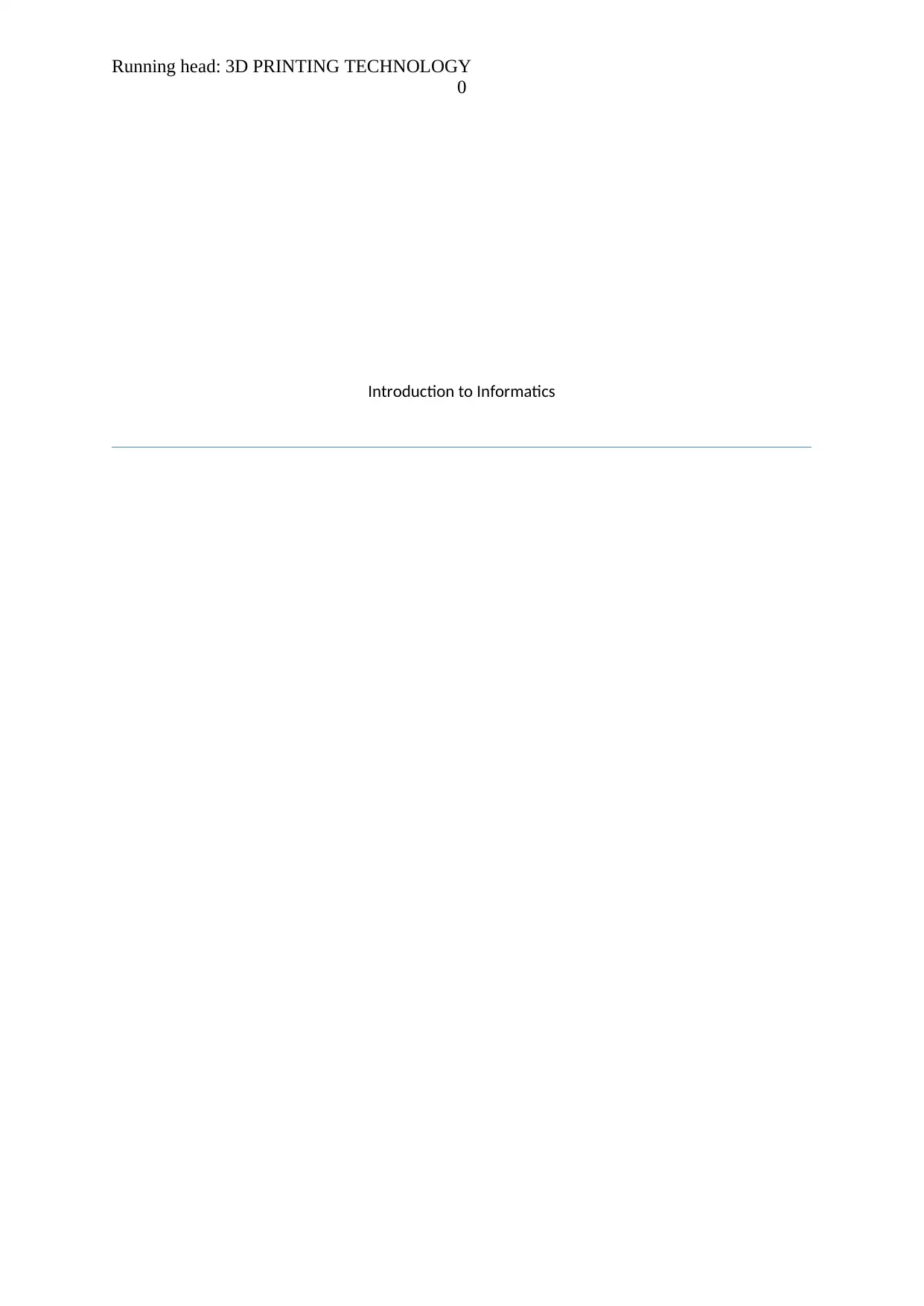
Running head: 3D PRINTING TECHNOLOGY
0
Introduction to Informatics
0
Introduction to Informatics
Secure Best Marks with AI Grader
Need help grading? Try our AI Grader for instant feedback on your assignments.

3D PRINTING TECHNOLOGY 1
Executive Summary
Many times modern technology has revolutionised the manufacturing procedure in various
industries, and as per the research of investment firms, the 3D printing technology will
transform the production procedure. The 3D printing technology is also called additive
manufacturing because objects are products by adding one cross-sectional layer at a time,
unlike other methods of fabrication which uses the subtractive procedure. With the help of
3D printing machines, companies can manufacture significantly complicated products using
computer modeling. The additive manufacturing is more suitable for low volume production;
small corporations use this method to produce a low quantity of products at lower expenses.
The 3D printing technology is significantly valuable in the medical sector; it assists in the
manufacturing of hearing aid devices, prosthetic arm/leg, and protection gadgets. These
products are produced in low quantity and additive manufacturing procedure benefit
enterprise by reducing their production cost. There have been various studies conducted by
leading research firms such as PwC, The Economist, and DHL; the researchers predicted that
3D technology would revolutionise the production industry and influenced multiple sectors.
Many traditional methods of manufacturing such as injection molding and outsourcing
production work will obsolete due to the popularity of 3D printing technology because it will
make the manufacturing process more straightforward. The consumers will be benefited by
the popularity of additive manufacturing because it will assist them producing their own
products at home.
Executive Summary
Many times modern technology has revolutionised the manufacturing procedure in various
industries, and as per the research of investment firms, the 3D printing technology will
transform the production procedure. The 3D printing technology is also called additive
manufacturing because objects are products by adding one cross-sectional layer at a time,
unlike other methods of fabrication which uses the subtractive procedure. With the help of
3D printing machines, companies can manufacture significantly complicated products using
computer modeling. The additive manufacturing is more suitable for low volume production;
small corporations use this method to produce a low quantity of products at lower expenses.
The 3D printing technology is significantly valuable in the medical sector; it assists in the
manufacturing of hearing aid devices, prosthetic arm/leg, and protection gadgets. These
products are produced in low quantity and additive manufacturing procedure benefit
enterprise by reducing their production cost. There have been various studies conducted by
leading research firms such as PwC, The Economist, and DHL; the researchers predicted that
3D technology would revolutionise the production industry and influenced multiple sectors.
Many traditional methods of manufacturing such as injection molding and outsourcing
production work will obsolete due to the popularity of 3D printing technology because it will
make the manufacturing process more straightforward. The consumers will be benefited by
the popularity of additive manufacturing because it will assist them producing their own
products at home.
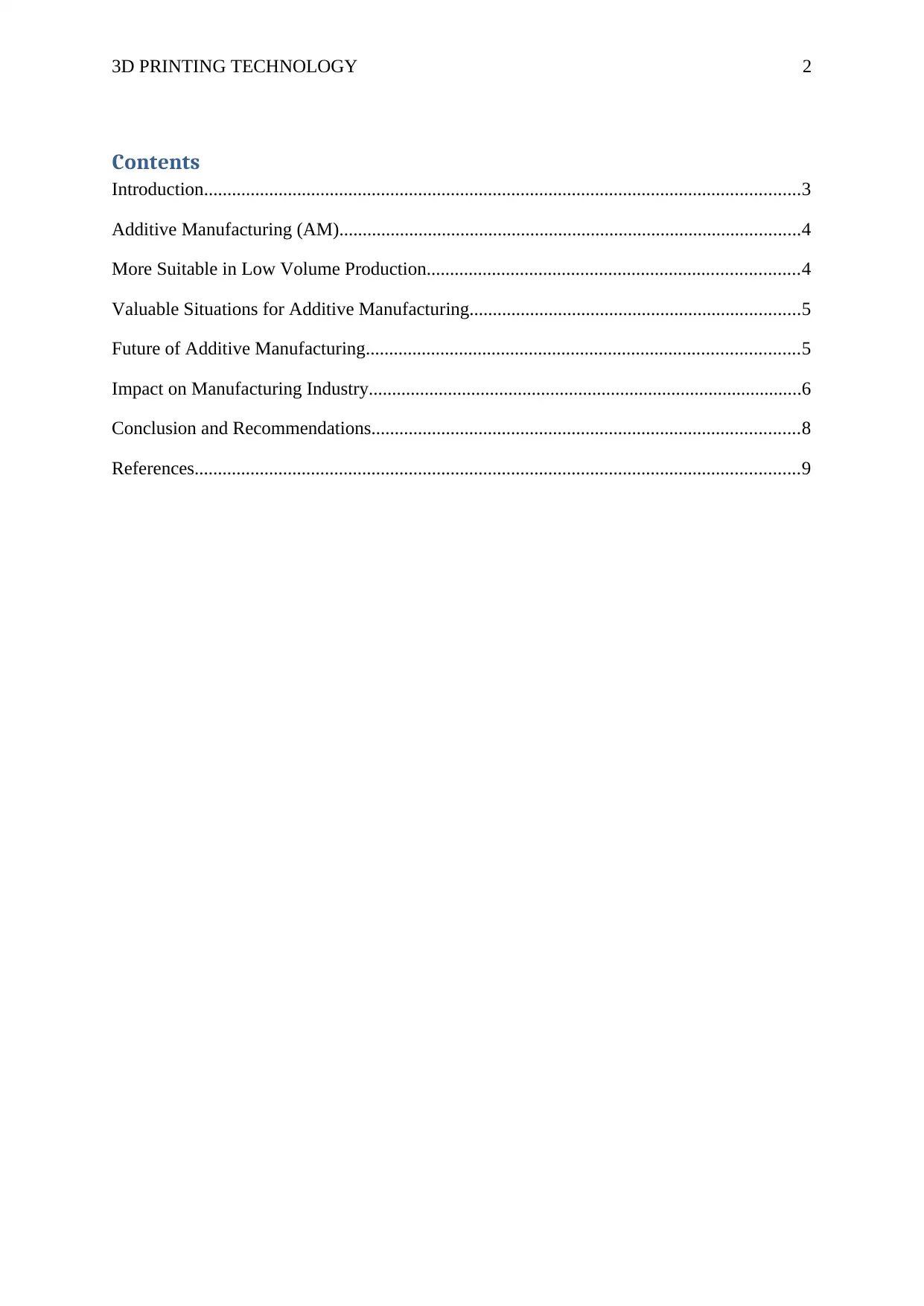
3D PRINTING TECHNOLOGY 2
Contents
Introduction................................................................................................................................3
Additive Manufacturing (AM)...................................................................................................4
More Suitable in Low Volume Production................................................................................4
Valuable Situations for Additive Manufacturing.......................................................................5
Future of Additive Manufacturing.............................................................................................5
Impact on Manufacturing Industry.............................................................................................6
Conclusion and Recommendations............................................................................................8
References..................................................................................................................................9
Contents
Introduction................................................................................................................................3
Additive Manufacturing (AM)...................................................................................................4
More Suitable in Low Volume Production................................................................................4
Valuable Situations for Additive Manufacturing.......................................................................5
Future of Additive Manufacturing.............................................................................................5
Impact on Manufacturing Industry.............................................................................................6
Conclusion and Recommendations............................................................................................8
References..................................................................................................................................9
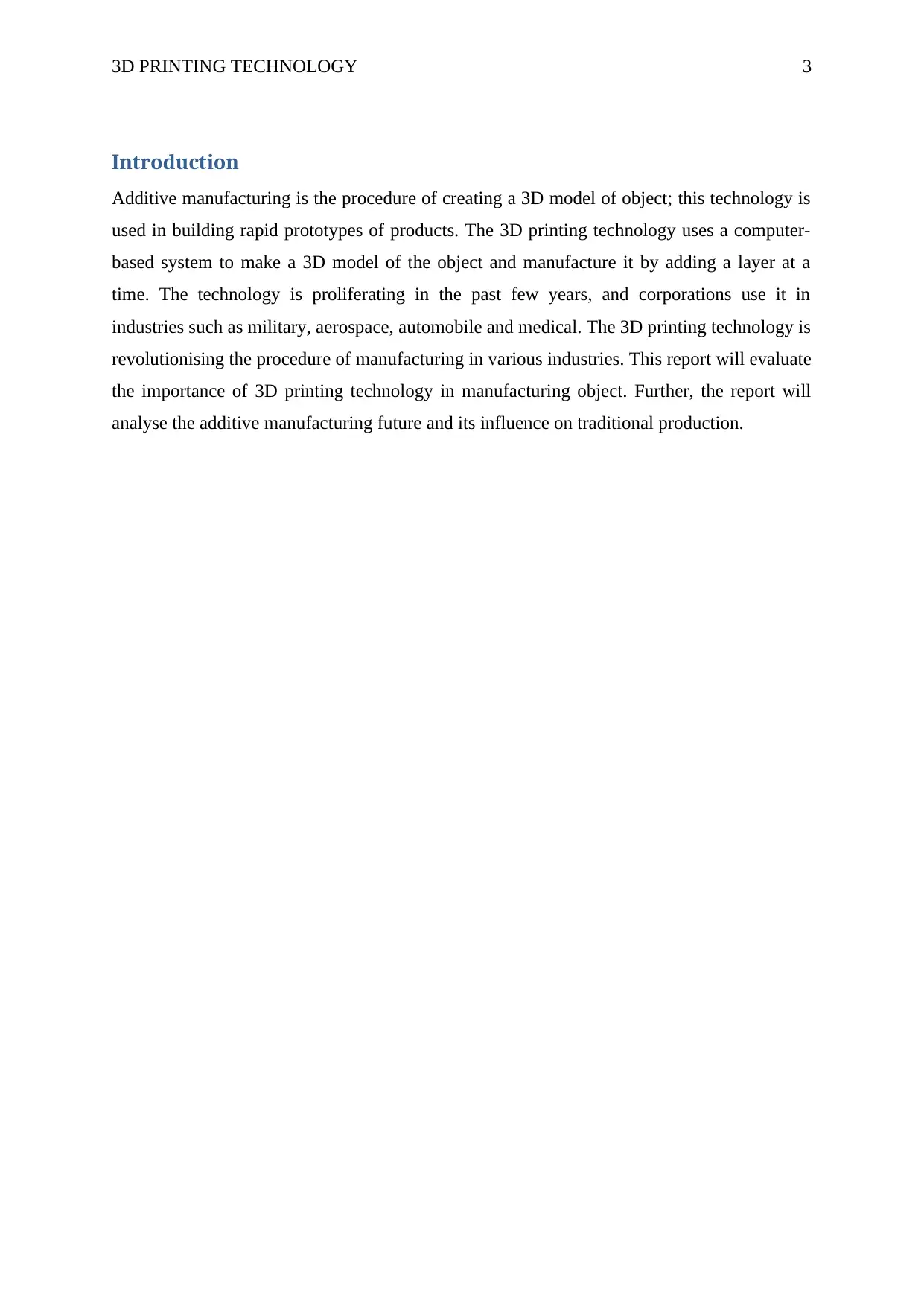
3D PRINTING TECHNOLOGY 3
Introduction
Additive manufacturing is the procedure of creating a 3D model of object; this technology is
used in building rapid prototypes of products. The 3D printing technology uses a computer-
based system to make a 3D model of the object and manufacture it by adding a layer at a
time. The technology is proliferating in the past few years, and corporations use it in
industries such as military, aerospace, automobile and medical. The 3D printing technology is
revolutionising the procedure of manufacturing in various industries. This report will evaluate
the importance of 3D printing technology in manufacturing object. Further, the report will
analyse the additive manufacturing future and its influence on traditional production.
Introduction
Additive manufacturing is the procedure of creating a 3D model of object; this technology is
used in building rapid prototypes of products. The 3D printing technology uses a computer-
based system to make a 3D model of the object and manufacture it by adding a layer at a
time. The technology is proliferating in the past few years, and corporations use it in
industries such as military, aerospace, automobile and medical. The 3D printing technology is
revolutionising the procedure of manufacturing in various industries. This report will evaluate
the importance of 3D printing technology in manufacturing object. Further, the report will
analyse the additive manufacturing future and its influence on traditional production.
Secure Best Marks with AI Grader
Need help grading? Try our AI Grader for instant feedback on your assignments.

3D PRINTING TECHNOLOGY 4
Additive Manufacturing (AM)
The industrial revolution in manufacturing industry has changed the world in previous
decades; modern production technology uses the latest technology to improve the efficiency
of the process. Various advancement such as injection molding assisted corporation into
manufacturing process such as forming and molding by performing complex production
functions. These technologies are a part of the subtractive method in which products are
manufactured by subtracting material from the object. In 3D printing technology, the
products are formed by adding alter at a time, hence it is also known as additive
manufacturing (Campbell, Williams, Ivanova, and Garrett, 2011).
In additive manufacturing, one cross-sectional layer of material is added by the machine to
form the product, the process of cutting, molding, and forming is not required in 3D printing
technology. As per Mishra (2014), the technology uses complex computer technology into
constructing a 3D model of the object; then computer sends such data to the AM machine
which added a layer to manufacture such product. One cross-sectional layer of material is
attached to the device to give structure to the product which helps in the production of
complex objects.
More Suitable in Low Volume Production
Instead of high volume production of the products, 3D printing technology is beneficial in
case of small volume production. The 3D printing technology was used in creating repaid
prototypes of the product, but the advancement of technology has assisted in use of this
technology in the manufacturing procedure. The technology allows engineers to customise,
assemble and design their complex products; 3D printing can manufacture low volume of
objects at a cheaper cost. Traditionally, the manufacturing procedure reduces the price only
after the production is high (Weller, Kleer and Piller 2015).
Injection molding process is better in producing a large number of plastic products which is
cheaper to produce in high volume. The 3D printing technology reduces the wastage because
it uses more than 90 percent of the materials. It is also beneficial in reducing environmental
damage; the energy consumption of technology is even lower than compared to other
methods of production. As per Frazier (2014), various industries are already benefiting from
the advantages of 3D printing technology, such as medical, military and automobile. Many
Additive Manufacturing (AM)
The industrial revolution in manufacturing industry has changed the world in previous
decades; modern production technology uses the latest technology to improve the efficiency
of the process. Various advancement such as injection molding assisted corporation into
manufacturing process such as forming and molding by performing complex production
functions. These technologies are a part of the subtractive method in which products are
manufactured by subtracting material from the object. In 3D printing technology, the
products are formed by adding alter at a time, hence it is also known as additive
manufacturing (Campbell, Williams, Ivanova, and Garrett, 2011).
In additive manufacturing, one cross-sectional layer of material is added by the machine to
form the product, the process of cutting, molding, and forming is not required in 3D printing
technology. As per Mishra (2014), the technology uses complex computer technology into
constructing a 3D model of the object; then computer sends such data to the AM machine
which added a layer to manufacture such product. One cross-sectional layer of material is
attached to the device to give structure to the product which helps in the production of
complex objects.
More Suitable in Low Volume Production
Instead of high volume production of the products, 3D printing technology is beneficial in
case of small volume production. The 3D printing technology was used in creating repaid
prototypes of the product, but the advancement of technology has assisted in use of this
technology in the manufacturing procedure. The technology allows engineers to customise,
assemble and design their complex products; 3D printing can manufacture low volume of
objects at a cheaper cost. Traditionally, the manufacturing procedure reduces the price only
after the production is high (Weller, Kleer and Piller 2015).
Injection molding process is better in producing a large number of plastic products which is
cheaper to produce in high volume. The 3D printing technology reduces the wastage because
it uses more than 90 percent of the materials. It is also beneficial in reducing environmental
damage; the energy consumption of technology is even lower than compared to other
methods of production. As per Frazier (2014), various industries are already benefiting from
the advantages of 3D printing technology, such as medical, military and automobile. Many
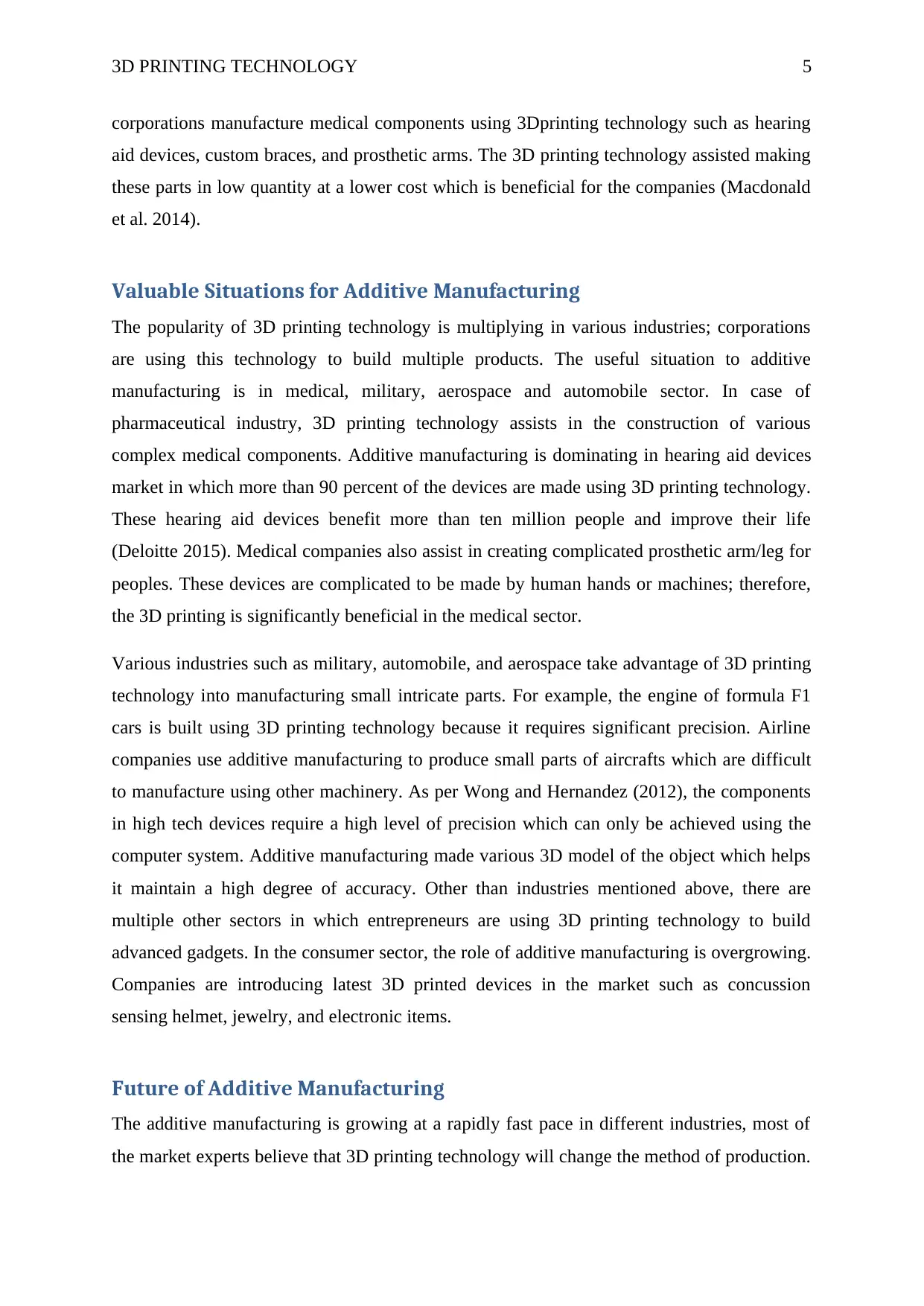
3D PRINTING TECHNOLOGY 5
corporations manufacture medical components using 3Dprinting technology such as hearing
aid devices, custom braces, and prosthetic arms. The 3D printing technology assisted making
these parts in low quantity at a lower cost which is beneficial for the companies (Macdonald
et al. 2014).
Valuable Situations for Additive Manufacturing
The popularity of 3D printing technology is multiplying in various industries; corporations
are using this technology to build multiple products. The useful situation to additive
manufacturing is in medical, military, aerospace and automobile sector. In case of
pharmaceutical industry, 3D printing technology assists in the construction of various
complex medical components. Additive manufacturing is dominating in hearing aid devices
market in which more than 90 percent of the devices are made using 3D printing technology.
These hearing aid devices benefit more than ten million people and improve their life
(Deloitte 2015). Medical companies also assist in creating complicated prosthetic arm/leg for
peoples. These devices are complicated to be made by human hands or machines; therefore,
the 3D printing is significantly beneficial in the medical sector.
Various industries such as military, automobile, and aerospace take advantage of 3D printing
technology into manufacturing small intricate parts. For example, the engine of formula F1
cars is built using 3D printing technology because it requires significant precision. Airline
companies use additive manufacturing to produce small parts of aircrafts which are difficult
to manufacture using other machinery. As per Wong and Hernandez (2012), the components
in high tech devices require a high level of precision which can only be achieved using the
computer system. Additive manufacturing made various 3D model of the object which helps
it maintain a high degree of accuracy. Other than industries mentioned above, there are
multiple other sectors in which entrepreneurs are using 3D printing technology to build
advanced gadgets. In the consumer sector, the role of additive manufacturing is overgrowing.
Companies are introducing latest 3D printed devices in the market such as concussion
sensing helmet, jewelry, and electronic items.
Future of Additive Manufacturing
The additive manufacturing is growing at a rapidly fast pace in different industries, most of
the market experts believe that 3D printing technology will change the method of production.
corporations manufacture medical components using 3Dprinting technology such as hearing
aid devices, custom braces, and prosthetic arms. The 3D printing technology assisted making
these parts in low quantity at a lower cost which is beneficial for the companies (Macdonald
et al. 2014).
Valuable Situations for Additive Manufacturing
The popularity of 3D printing technology is multiplying in various industries; corporations
are using this technology to build multiple products. The useful situation to additive
manufacturing is in medical, military, aerospace and automobile sector. In case of
pharmaceutical industry, 3D printing technology assists in the construction of various
complex medical components. Additive manufacturing is dominating in hearing aid devices
market in which more than 90 percent of the devices are made using 3D printing technology.
These hearing aid devices benefit more than ten million people and improve their life
(Deloitte 2015). Medical companies also assist in creating complicated prosthetic arm/leg for
peoples. These devices are complicated to be made by human hands or machines; therefore,
the 3D printing is significantly beneficial in the medical sector.
Various industries such as military, automobile, and aerospace take advantage of 3D printing
technology into manufacturing small intricate parts. For example, the engine of formula F1
cars is built using 3D printing technology because it requires significant precision. Airline
companies use additive manufacturing to produce small parts of aircrafts which are difficult
to manufacture using other machinery. As per Wong and Hernandez (2012), the components
in high tech devices require a high level of precision which can only be achieved using the
computer system. Additive manufacturing made various 3D model of the object which helps
it maintain a high degree of accuracy. Other than industries mentioned above, there are
multiple other sectors in which entrepreneurs are using 3D printing technology to build
advanced gadgets. In the consumer sector, the role of additive manufacturing is overgrowing.
Companies are introducing latest 3D printed devices in the market such as concussion
sensing helmet, jewelry, and electronic items.
Future of Additive Manufacturing
The additive manufacturing is growing at a rapidly fast pace in different industries, most of
the market experts believe that 3D printing technology will change the method of production.
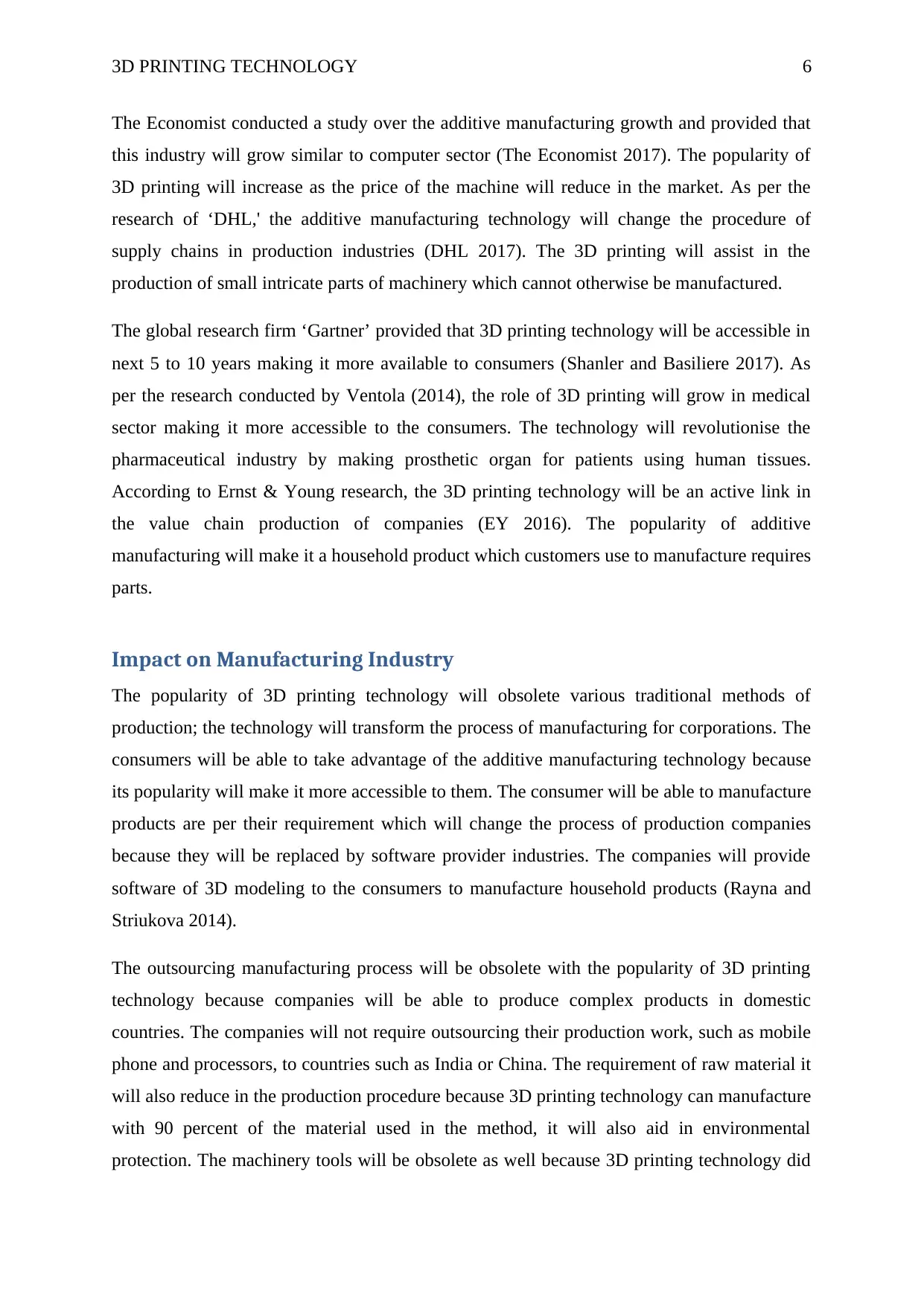
3D PRINTING TECHNOLOGY 6
The Economist conducted a study over the additive manufacturing growth and provided that
this industry will grow similar to computer sector (The Economist 2017). The popularity of
3D printing will increase as the price of the machine will reduce in the market. As per the
research of ‘DHL,' the additive manufacturing technology will change the procedure of
supply chains in production industries (DHL 2017). The 3D printing will assist in the
production of small intricate parts of machinery which cannot otherwise be manufactured.
The global research firm ‘Gartner’ provided that 3D printing technology will be accessible in
next 5 to 10 years making it more available to consumers (Shanler and Basiliere 2017). As
per the research conducted by Ventola (2014), the role of 3D printing will grow in medical
sector making it more accessible to the consumers. The technology will revolutionise the
pharmaceutical industry by making prosthetic organ for patients using human tissues.
According to Ernst & Young research, the 3D printing technology will be an active link in
the value chain production of companies (EY 2016). The popularity of additive
manufacturing will make it a household product which customers use to manufacture requires
parts.
Impact on Manufacturing Industry
The popularity of 3D printing technology will obsolete various traditional methods of
production; the technology will transform the process of manufacturing for corporations. The
consumers will be able to take advantage of the additive manufacturing technology because
its popularity will make it more accessible to them. The consumer will be able to manufacture
products are per their requirement which will change the process of production companies
because they will be replaced by software provider industries. The companies will provide
software of 3D modeling to the consumers to manufacture household products (Rayna and
Striukova 2014).
The outsourcing manufacturing process will be obsolete with the popularity of 3D printing
technology because companies will be able to produce complex products in domestic
countries. The companies will not require outsourcing their production work, such as mobile
phone and processors, to countries such as India or China. The requirement of raw material it
will also reduce in the production procedure because 3D printing technology can manufacture
with 90 percent of the material used in the method, it will also aid in environmental
protection. The machinery tools will be obsolete as well because 3D printing technology did
The Economist conducted a study over the additive manufacturing growth and provided that
this industry will grow similar to computer sector (The Economist 2017). The popularity of
3D printing will increase as the price of the machine will reduce in the market. As per the
research of ‘DHL,' the additive manufacturing technology will change the procedure of
supply chains in production industries (DHL 2017). The 3D printing will assist in the
production of small intricate parts of machinery which cannot otherwise be manufactured.
The global research firm ‘Gartner’ provided that 3D printing technology will be accessible in
next 5 to 10 years making it more available to consumers (Shanler and Basiliere 2017). As
per the research conducted by Ventola (2014), the role of 3D printing will grow in medical
sector making it more accessible to the consumers. The technology will revolutionise the
pharmaceutical industry by making prosthetic organ for patients using human tissues.
According to Ernst & Young research, the 3D printing technology will be an active link in
the value chain production of companies (EY 2016). The popularity of additive
manufacturing will make it a household product which customers use to manufacture requires
parts.
Impact on Manufacturing Industry
The popularity of 3D printing technology will obsolete various traditional methods of
production; the technology will transform the process of manufacturing for corporations. The
consumers will be able to take advantage of the additive manufacturing technology because
its popularity will make it more accessible to them. The consumer will be able to manufacture
products are per their requirement which will change the process of production companies
because they will be replaced by software provider industries. The companies will provide
software of 3D modeling to the consumers to manufacture household products (Rayna and
Striukova 2014).
The outsourcing manufacturing process will be obsolete with the popularity of 3D printing
technology because companies will be able to produce complex products in domestic
countries. The companies will not require outsourcing their production work, such as mobile
phone and processors, to countries such as India or China. The requirement of raw material it
will also reduce in the production procedure because 3D printing technology can manufacture
with 90 percent of the material used in the method, it will also aid in environmental
protection. The machinery tools will be obsolete as well because 3D printing technology did
Paraphrase This Document
Need a fresh take? Get an instant paraphrase of this document with our AI Paraphraser
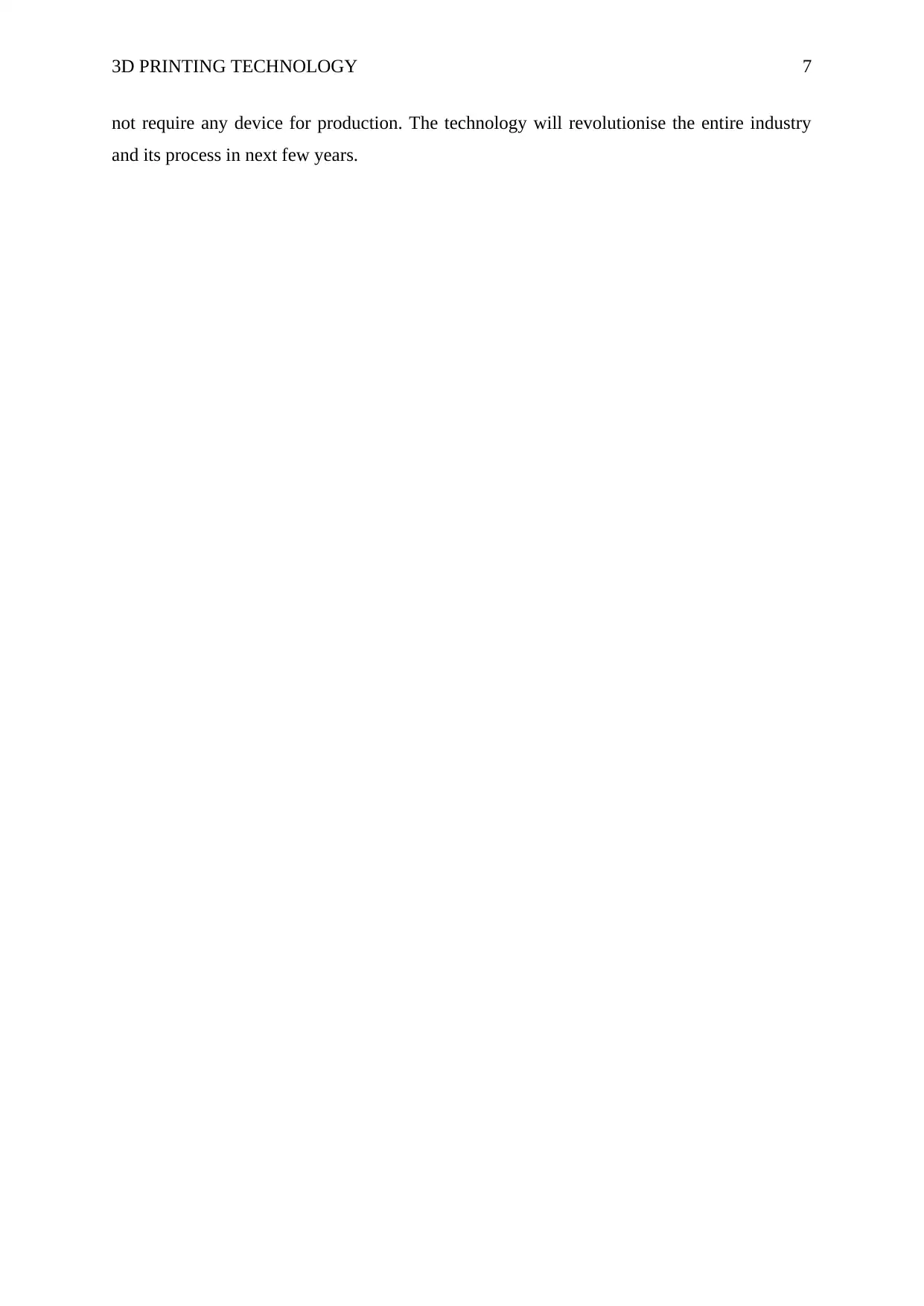
3D PRINTING TECHNOLOGY 7
not require any device for production. The technology will revolutionise the entire industry
and its process in next few years.
not require any device for production. The technology will revolutionise the entire industry
and its process in next few years.
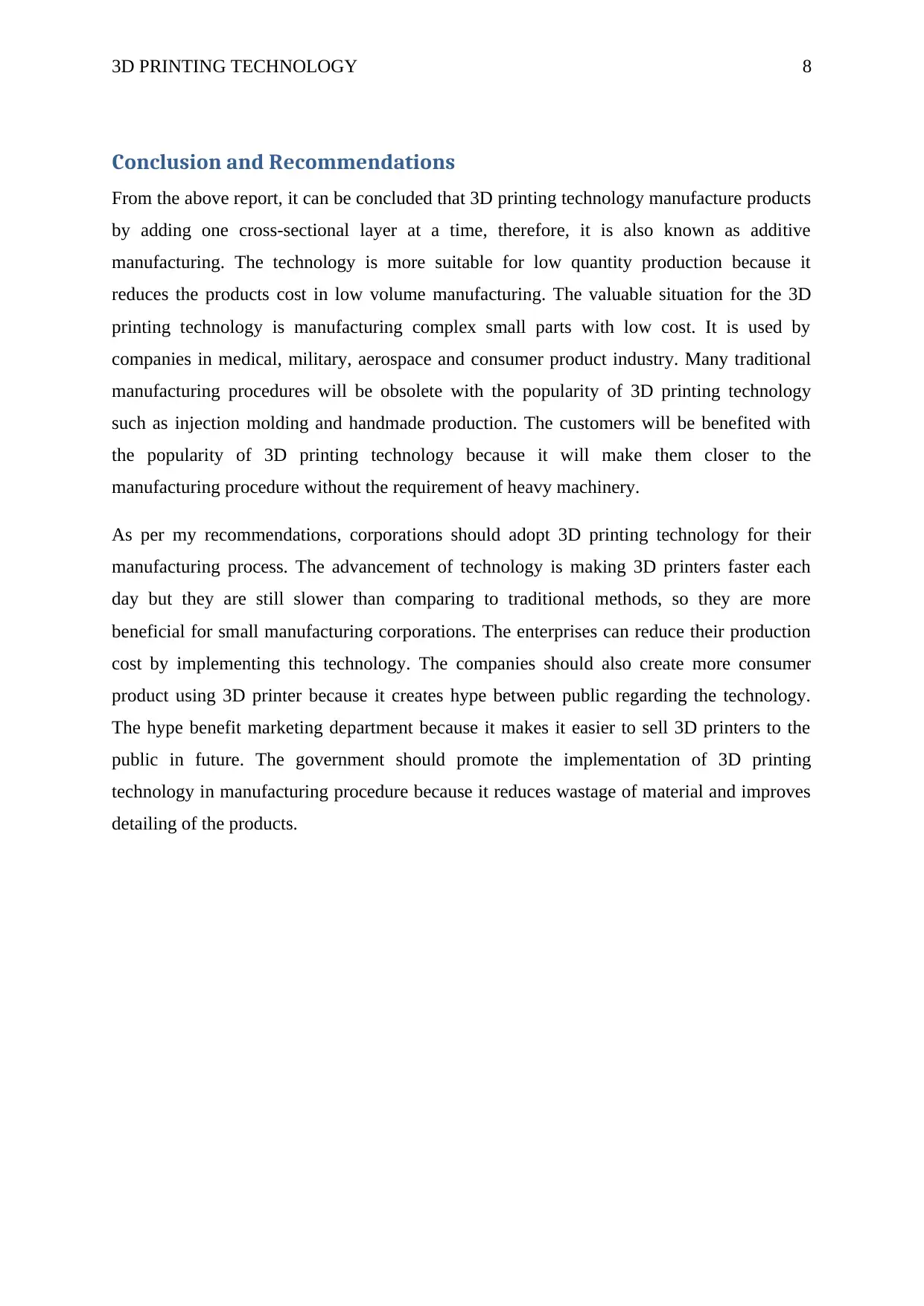
3D PRINTING TECHNOLOGY 8
Conclusion and Recommendations
From the above report, it can be concluded that 3D printing technology manufacture products
by adding one cross-sectional layer at a time, therefore, it is also known as additive
manufacturing. The technology is more suitable for low quantity production because it
reduces the products cost in low volume manufacturing. The valuable situation for the 3D
printing technology is manufacturing complex small parts with low cost. It is used by
companies in medical, military, aerospace and consumer product industry. Many traditional
manufacturing procedures will be obsolete with the popularity of 3D printing technology
such as injection molding and handmade production. The customers will be benefited with
the popularity of 3D printing technology because it will make them closer to the
manufacturing procedure without the requirement of heavy machinery.
As per my recommendations, corporations should adopt 3D printing technology for their
manufacturing process. The advancement of technology is making 3D printers faster each
day but they are still slower than comparing to traditional methods, so they are more
beneficial for small manufacturing corporations. The enterprises can reduce their production
cost by implementing this technology. The companies should also create more consumer
product using 3D printer because it creates hype between public regarding the technology.
The hype benefit marketing department because it makes it easier to sell 3D printers to the
public in future. The government should promote the implementation of 3D printing
technology in manufacturing procedure because it reduces wastage of material and improves
detailing of the products.
Conclusion and Recommendations
From the above report, it can be concluded that 3D printing technology manufacture products
by adding one cross-sectional layer at a time, therefore, it is also known as additive
manufacturing. The technology is more suitable for low quantity production because it
reduces the products cost in low volume manufacturing. The valuable situation for the 3D
printing technology is manufacturing complex small parts with low cost. It is used by
companies in medical, military, aerospace and consumer product industry. Many traditional
manufacturing procedures will be obsolete with the popularity of 3D printing technology
such as injection molding and handmade production. The customers will be benefited with
the popularity of 3D printing technology because it will make them closer to the
manufacturing procedure without the requirement of heavy machinery.
As per my recommendations, corporations should adopt 3D printing technology for their
manufacturing process. The advancement of technology is making 3D printers faster each
day but they are still slower than comparing to traditional methods, so they are more
beneficial for small manufacturing corporations. The enterprises can reduce their production
cost by implementing this technology. The companies should also create more consumer
product using 3D printer because it creates hype between public regarding the technology.
The hype benefit marketing department because it makes it easier to sell 3D printers to the
public in future. The government should promote the implementation of 3D printing
technology in manufacturing procedure because it reduces wastage of material and improves
detailing of the products.
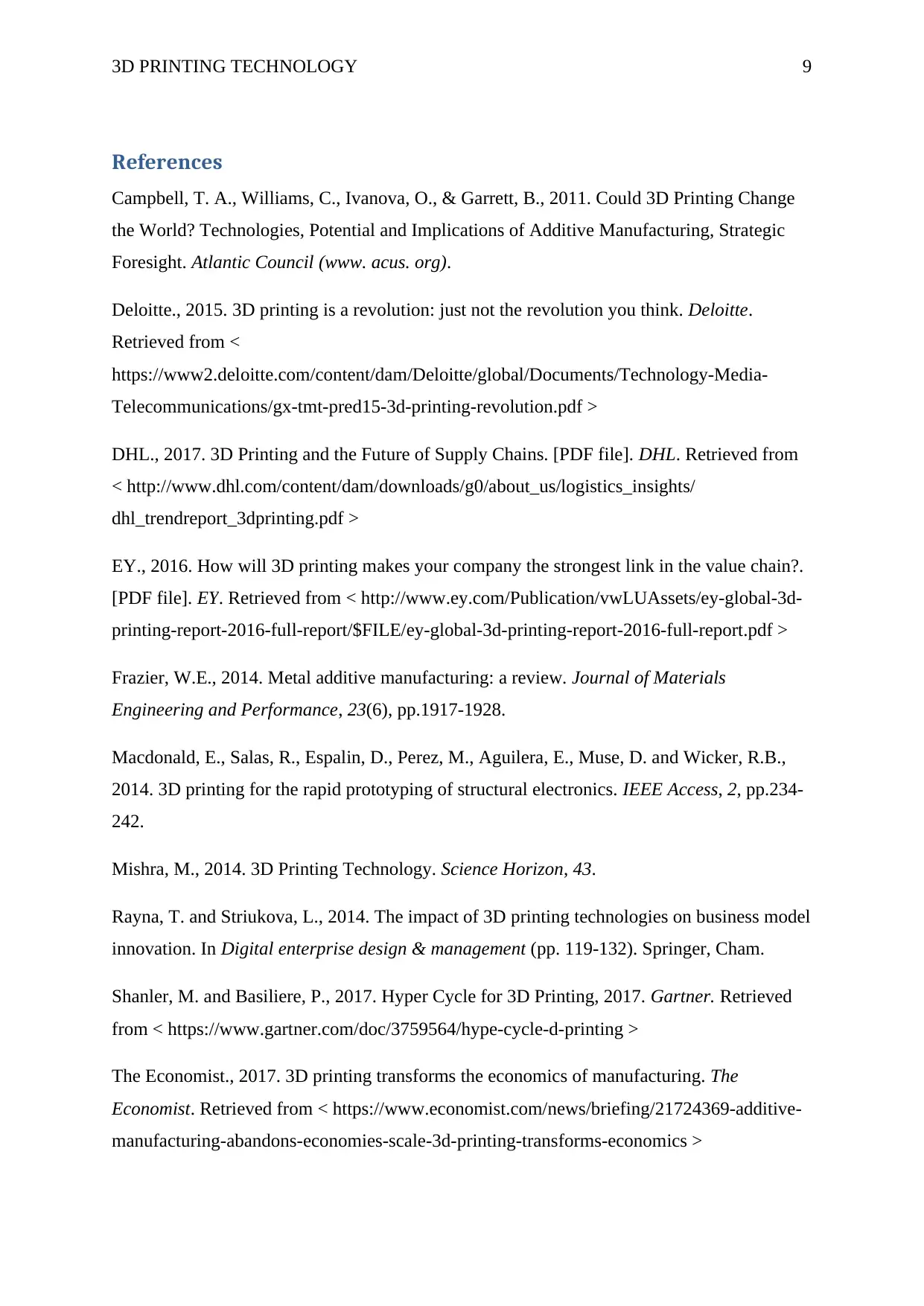
3D PRINTING TECHNOLOGY 9
References
Campbell, T. A., Williams, C., Ivanova, O., & Garrett, B., 2011. Could 3D Printing Change
the World? Technologies, Potential and Implications of Additive Manufacturing, Strategic
Foresight. Atlantic Council (www. acus. org).
Deloitte., 2015. 3D printing is a revolution: just not the revolution you think. Deloitte.
Retrieved from <
https://www2.deloitte.com/content/dam/Deloitte/global/Documents/Technology-Media-
Telecommunications/gx-tmt-pred15-3d-printing-revolution.pdf >
DHL., 2017. 3D Printing and the Future of Supply Chains. [PDF file]. DHL. Retrieved from
< http://www.dhl.com/content/dam/downloads/g0/about_us/logistics_insights/
dhl_trendreport_3dprinting.pdf >
EY., 2016. How will 3D printing makes your company the strongest link in the value chain?.
[PDF file]. EY. Retrieved from < http://www.ey.com/Publication/vwLUAssets/ey-global-3d-
printing-report-2016-full-report/$FILE/ey-global-3d-printing-report-2016-full-report.pdf >
Frazier, W.E., 2014. Metal additive manufacturing: a review. Journal of Materials
Engineering and Performance, 23(6), pp.1917-1928.
Macdonald, E., Salas, R., Espalin, D., Perez, M., Aguilera, E., Muse, D. and Wicker, R.B.,
2014. 3D printing for the rapid prototyping of structural electronics. IEEE Access, 2, pp.234-
242.
Mishra, M., 2014. 3D Printing Technology. Science Horizon, 43.
Rayna, T. and Striukova, L., 2014. The impact of 3D printing technologies on business model
innovation. In Digital enterprise design & management (pp. 119-132). Springer, Cham.
Shanler, M. and Basiliere, P., 2017. Hyper Cycle for 3D Printing, 2017. Gartner. Retrieved
from < https://www.gartner.com/doc/3759564/hype-cycle-d-printing >
The Economist., 2017. 3D printing transforms the economics of manufacturing. The
Economist. Retrieved from < https://www.economist.com/news/briefing/21724369-additive-
manufacturing-abandons-economies-scale-3d-printing-transforms-economics >
References
Campbell, T. A., Williams, C., Ivanova, O., & Garrett, B., 2011. Could 3D Printing Change
the World? Technologies, Potential and Implications of Additive Manufacturing, Strategic
Foresight. Atlantic Council (www. acus. org).
Deloitte., 2015. 3D printing is a revolution: just not the revolution you think. Deloitte.
Retrieved from <
https://www2.deloitte.com/content/dam/Deloitte/global/Documents/Technology-Media-
Telecommunications/gx-tmt-pred15-3d-printing-revolution.pdf >
DHL., 2017. 3D Printing and the Future of Supply Chains. [PDF file]. DHL. Retrieved from
< http://www.dhl.com/content/dam/downloads/g0/about_us/logistics_insights/
dhl_trendreport_3dprinting.pdf >
EY., 2016. How will 3D printing makes your company the strongest link in the value chain?.
[PDF file]. EY. Retrieved from < http://www.ey.com/Publication/vwLUAssets/ey-global-3d-
printing-report-2016-full-report/$FILE/ey-global-3d-printing-report-2016-full-report.pdf >
Frazier, W.E., 2014. Metal additive manufacturing: a review. Journal of Materials
Engineering and Performance, 23(6), pp.1917-1928.
Macdonald, E., Salas, R., Espalin, D., Perez, M., Aguilera, E., Muse, D. and Wicker, R.B.,
2014. 3D printing for the rapid prototyping of structural electronics. IEEE Access, 2, pp.234-
242.
Mishra, M., 2014. 3D Printing Technology. Science Horizon, 43.
Rayna, T. and Striukova, L., 2014. The impact of 3D printing technologies on business model
innovation. In Digital enterprise design & management (pp. 119-132). Springer, Cham.
Shanler, M. and Basiliere, P., 2017. Hyper Cycle for 3D Printing, 2017. Gartner. Retrieved
from < https://www.gartner.com/doc/3759564/hype-cycle-d-printing >
The Economist., 2017. 3D printing transforms the economics of manufacturing. The
Economist. Retrieved from < https://www.economist.com/news/briefing/21724369-additive-
manufacturing-abandons-economies-scale-3d-printing-transforms-economics >
Secure Best Marks with AI Grader
Need help grading? Try our AI Grader for instant feedback on your assignments.
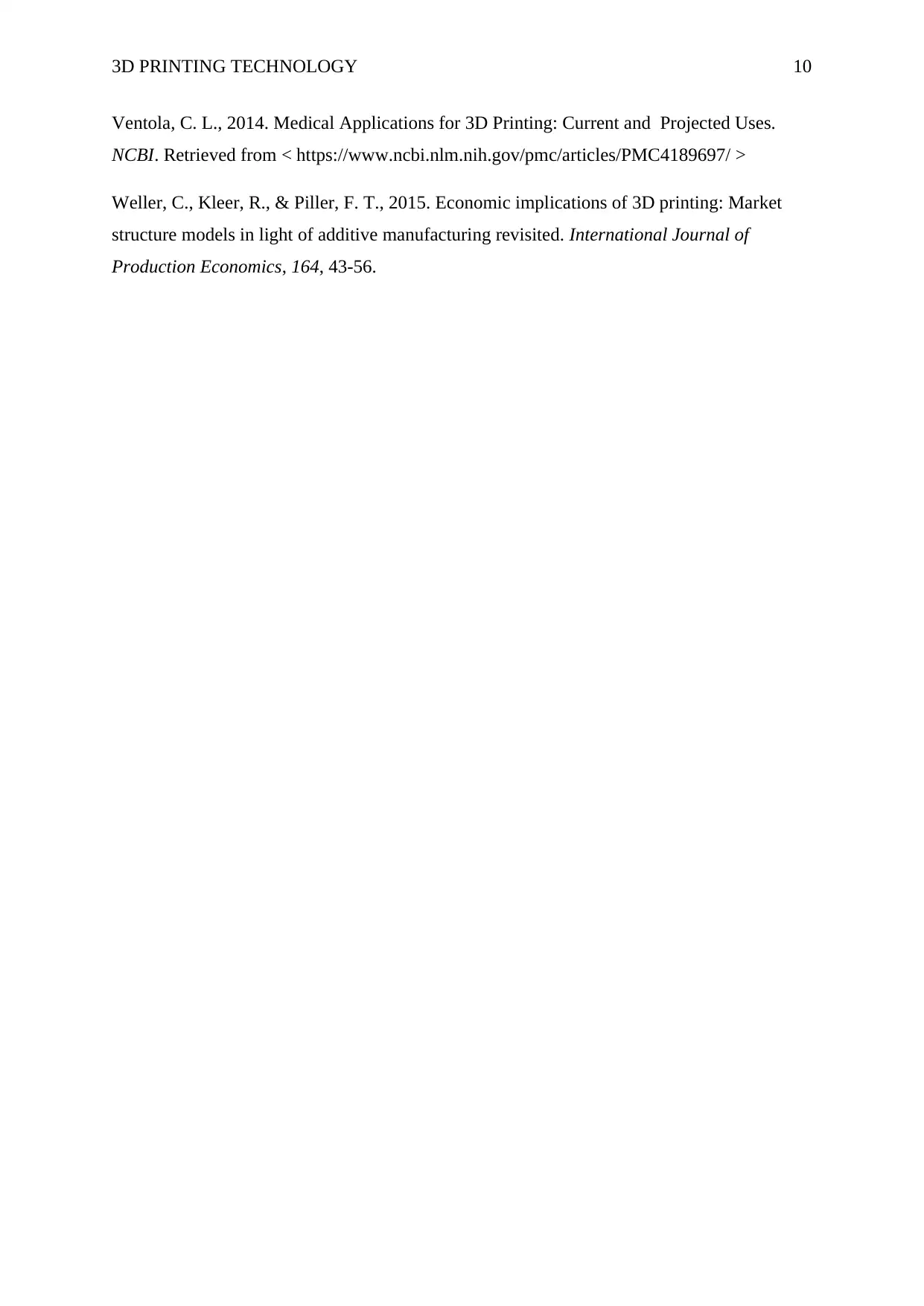
3D PRINTING TECHNOLOGY 10
Ventola, C. L., 2014. Medical Applications for 3D Printing: Current and Projected Uses.
NCBI. Retrieved from < https://www.ncbi.nlm.nih.gov/pmc/articles/PMC4189697/ >
Weller, C., Kleer, R., & Piller, F. T., 2015. Economic implications of 3D printing: Market
structure models in light of additive manufacturing revisited. International Journal of
Production Economics, 164, 43-56.
Ventola, C. L., 2014. Medical Applications for 3D Printing: Current and Projected Uses.
NCBI. Retrieved from < https://www.ncbi.nlm.nih.gov/pmc/articles/PMC4189697/ >
Weller, C., Kleer, R., & Piller, F. T., 2015. Economic implications of 3D printing: Market
structure models in light of additive manufacturing revisited. International Journal of
Production Economics, 164, 43-56.
1 out of 11
Related Documents
Your All-in-One AI-Powered Toolkit for Academic Success.
+13062052269
info@desklib.com
Available 24*7 on WhatsApp / Email
![[object Object]](/_next/static/media/star-bottom.7253800d.svg)
Unlock your academic potential
© 2024 | Zucol Services PVT LTD | All rights reserved.





